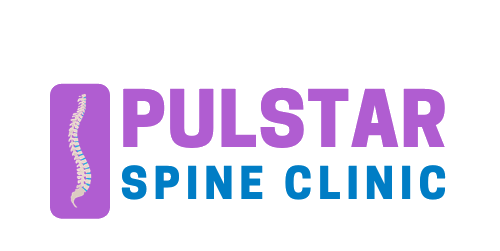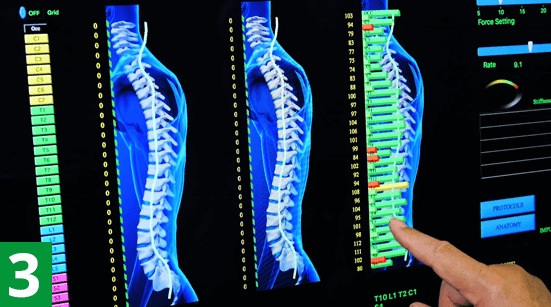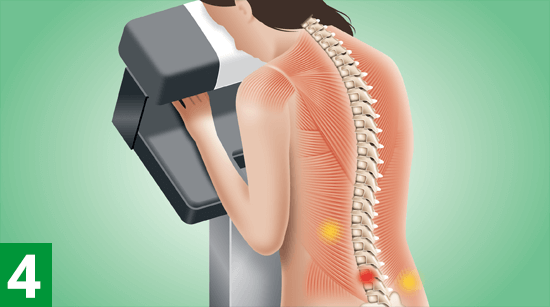Digital Spine Analysis
With Impulse Spine Analyzer
DSA or digital spine analysis is a revolutionary way for chiropractors to pinpoint the area of the spine that is affected in a patient. The Impulse Spine Analysis is an innovative spine function test for the diagnosis of spinal ailments and guides you towards spine treatments without surgery.
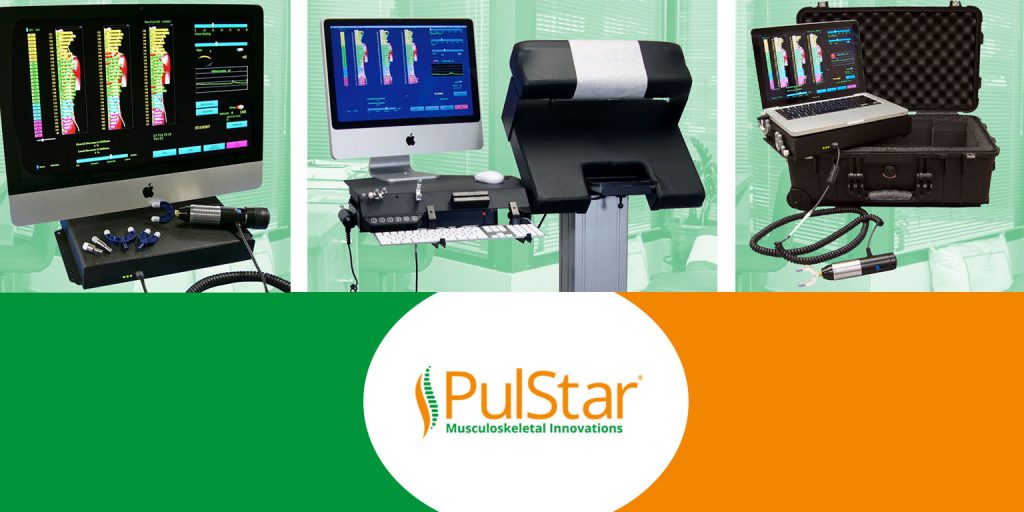
Digital Spine Analysis in Bangalore - DSA
With Impulse Spine Analyzer
In keeping up with the latest in scientific technology to best serve our patients, Pulstar Spine Clinic utilize the NASA technology to solve back and neck pain! By combining traditional chiropractic care with the revolutionary, most advanced, precise and patient-friendly technology of chiropractic technology, Pulstar Spine Clinic brings to you for the first time in India, “The spine analyzer”.
Back pain is one of the most common complaints for which people seek outpatient treatment. Yet, a striking rate of 45% of patients who suffer from any sort of back pain, tend to neglect it for more than 7 weeks. This often results in a delay in treatment. A majority of these people seek treatment for low back pain. Timely diagnosis and treatment can help to reduce the risk of surgeries. Modern tests like a digital spine analysis can greatly help in this regard.
Even today, X-ray, MRI and CT scans are used as diagnostic investigations. But there are certain conditions which do not appear in these scans. DSA offers an accurate diagnosis for these difficult, complicated cases.
Patients Treated
Years Experience
Satisfaction
Choosing Our Clinic, Choose The Best Care For You
Doctor and patient can see the effects of the treatment on screen. Patients have fewer visits to feeling better. And, improved patient satisfaction generates word-of-mouth referrals.
Request a Callback
What is Digital Spine Analysis?
Digital spine analysis (DSA) is a non-invasive test in order to measure the functioning of the spine.
The DSA is used for quantitative assessment strength, flexibility, and range of motions of the muscles supporting the spine.
DSA helps to specifically point towards the area of concern.
DSA is a fairly cost-effective technique to determine the exact area of problem and in-turn helps your therapist to provide you appropriate spine rehabilitation therapy. This is called target spine therapy (TST).
This therapy aims at treating only the weakened areas of the spine and correction of muscular imbalances.
The DSA up to some extent even helps to assess spine curvature and postural abnormalities. Furthermore, the treatment also aims at improvement of posture.
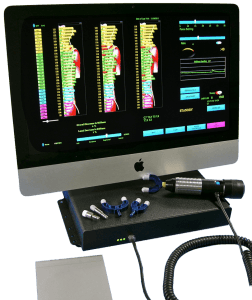
The DSA is used to assess not just spine problems, but also conditions involving other joints and their function and stability. Some conditions for which digital spine analysis can be conducted are:
- Sciatica
- Degenerative disc disease
- Spinal stenosis
- Spondylolisthesis
- Post-surgical pain
- Pain during the range of motion
- Compression fracture pain
- Sharp rib pain
- Neck pain and stiffness
- Degenerative arthritis
- Bulging discs
- Whiplash injuries
- Hip and knee joint pain
- Ankle pain and sprains
- Foot and heel pain
- Plantar fasciitis
- Shoulder pain
- Bursitis, tendonitis
- Frozen shoulder
- Tennis elbow
- Carpal tunnel syndrome
- Cervicogenic headaches
- Migraine and other headaches
- Insomnia
How Spine Analysis Can Help the treatment Plan?
- Before beginning any treatment, a therapist will obtain a detailed medical history of the patient, including onset, duration, and progress of current compliant, past history and family history.
- A history of previous medications should also be noted.
- A complete physical examination is done to rule out any other underlying cause for pain.
- Pain and functional disability before and after treatment are assessed.
- The device has a seat and paddles attached. Each paddle is meant to assess muscle strength, stability, flexibility and range of motions.
- A monitor is placed in front of the device which shows a graph-like reading for each range of movement.
- A report is obtained after the test which gives you details about the functioning of your spine and other joints. Your reading is given in comparison to reference values.
- In this way, the digital spine analysis helps in performing an accurate diagnosis. This in return helps our therapist to give you a tailor-made program to improve the functionality of specific muscles.
- Serial assessment is done once during the course of treatment and once at the end of treatment to evaluate the effects of your customized physiotherapy.
- The device-based therapy is ideally spread over 6 weeks including 18 sessions. The number of the session may be increased if required.
- Although, digital spine analysis is a considerably new addition in the field of medicine, there are some researchers who speak positively about the role of DSA in the management of a wide number of clinical conditions.
- Recent research conducted, showed that device-based therapy was found to improve functioning and reduce disability in patients having low back pain.
Case Studies
Another case study suggested that in a 31-year old individual suffering from cervical lordosis had complaints of stabbing pain in the ribs, arthritis of neck and numbness/ tingling in both hands. Following appropriate therapy, the patient showed significant improvement in objective outcomes. DSA-based therapy focused specifically upon restoration of the spinal curve. It was also noticed that the patient’s spine had undergone reorganizations and symptoms.
Another case report suggested that, in a 6-year old patient who had learning and concentration difficulties, along with severe abdominal pain (diagnosed as an abdominal migraine), had shown marked improvement in concentration and an absolute absence of abdominal pain following DSA-based therapy.
On the contrary, another randomized controlled trial was conducted on military recruits. This study reported that device-based specific strengthening did not offer satisfactory results as compared to routine physiotherapy for managing low back pain.
In spite of all the positive case results as well as researchers conducted, there are no studies which have shown long-term use and results of device-based therapy. This area could be further studied and researched.
Upper Extremities
- Shoulder Pain
- Arm Pain, Tingling, Numbness
- Bursitis
- Tendonitis
- Frozen Shoulder
- Limited Motions
- Arm Weakness
- Thoracic Outlet Syndrome
- Post Surgical Pain
- Elbow Pain
- Tennis Elbow
- Golfer’s Elbow
- Cubital Tunnel Syndrome
- Wrist & Hand Pain
- Carpal Tunnel Syndrome
- Thumb pain
- Hand weakness
Headaches
- Tension Headaches
- Migraine Headaches
- The base of Skull Headaches
- Headaches after Whiplash
- Cervicogenic headaches
- Dizziness/Vertigo
- Insomnia
- Fatigue
Lower Extremities
- Leg Pain, Weakness
- Hip Pain
- Trochanteric Bursitis
- Thigh Pains and Weakness
- Knee Pains
- Shin Splints
- Ankle Pains
- Ankle Sprains
- Foot Pain
- Heel Pain
- Plantar Fasciitis
- Fallen Arches/Pronation
Neck Conditions
- Neck Pain, Stiffness
- Muscle Tension
- Limited Motion
- Degenerative Arthritis
- Bulging Discs
- Whiplash Injuries
Low Back Pain
- Sciatica
- Leg Pain
- Bulging Discs (confirmed by MRI)
- Restless Leg Syndrome
- Degenerative Disc Disease
- Arthritis
- Spinal Stenosis
- Spondylolisthesis
- Sacroiliac Pain
- Post Laminectomy Syndrome*
- Post Surgical Pain *
- Surgical Back Fusions *
- Pain in Ranges of Motion
Mid-Back Conditions
- Rib Pain: Sharp
- Chest Pains
- Gastric Reflux
- Compression Fracture Pai
Other Conditions
- Fibromyalgia
- Rheumatoid Arthritis
